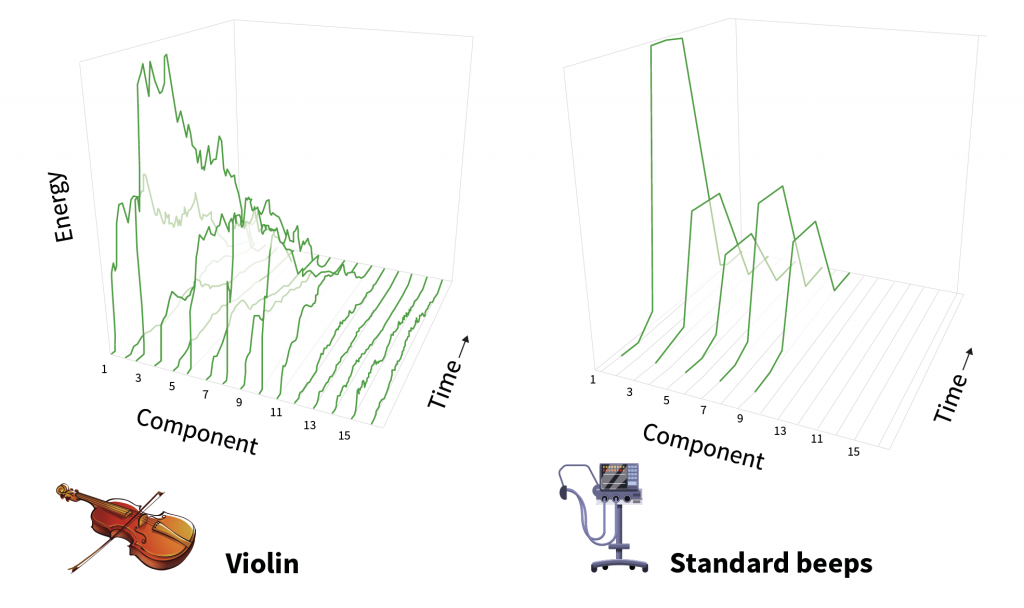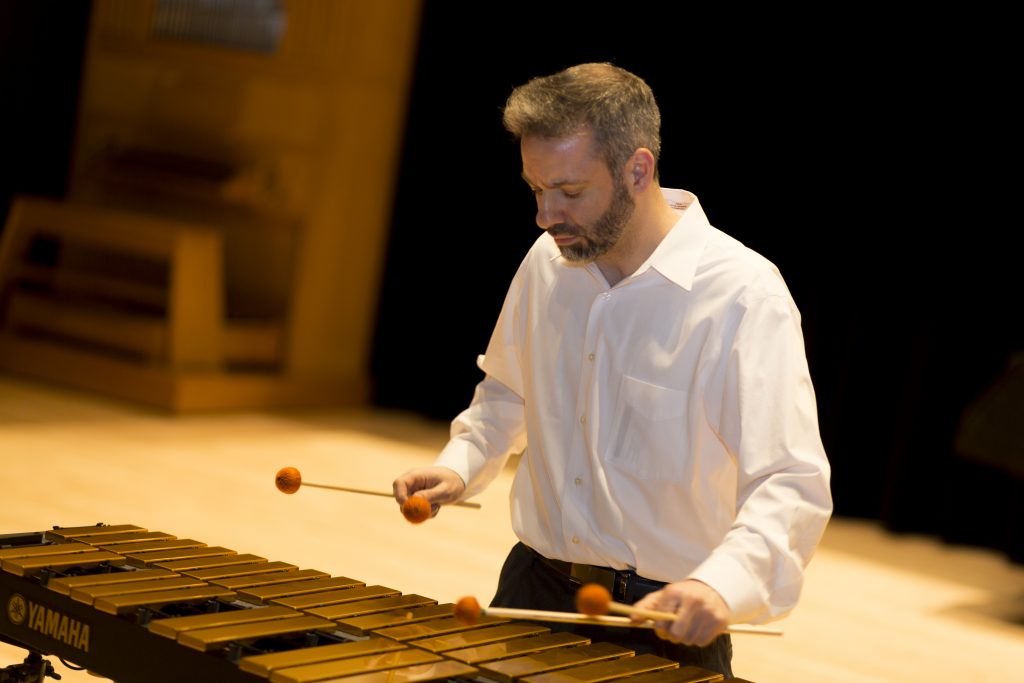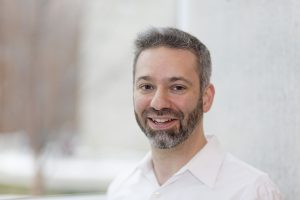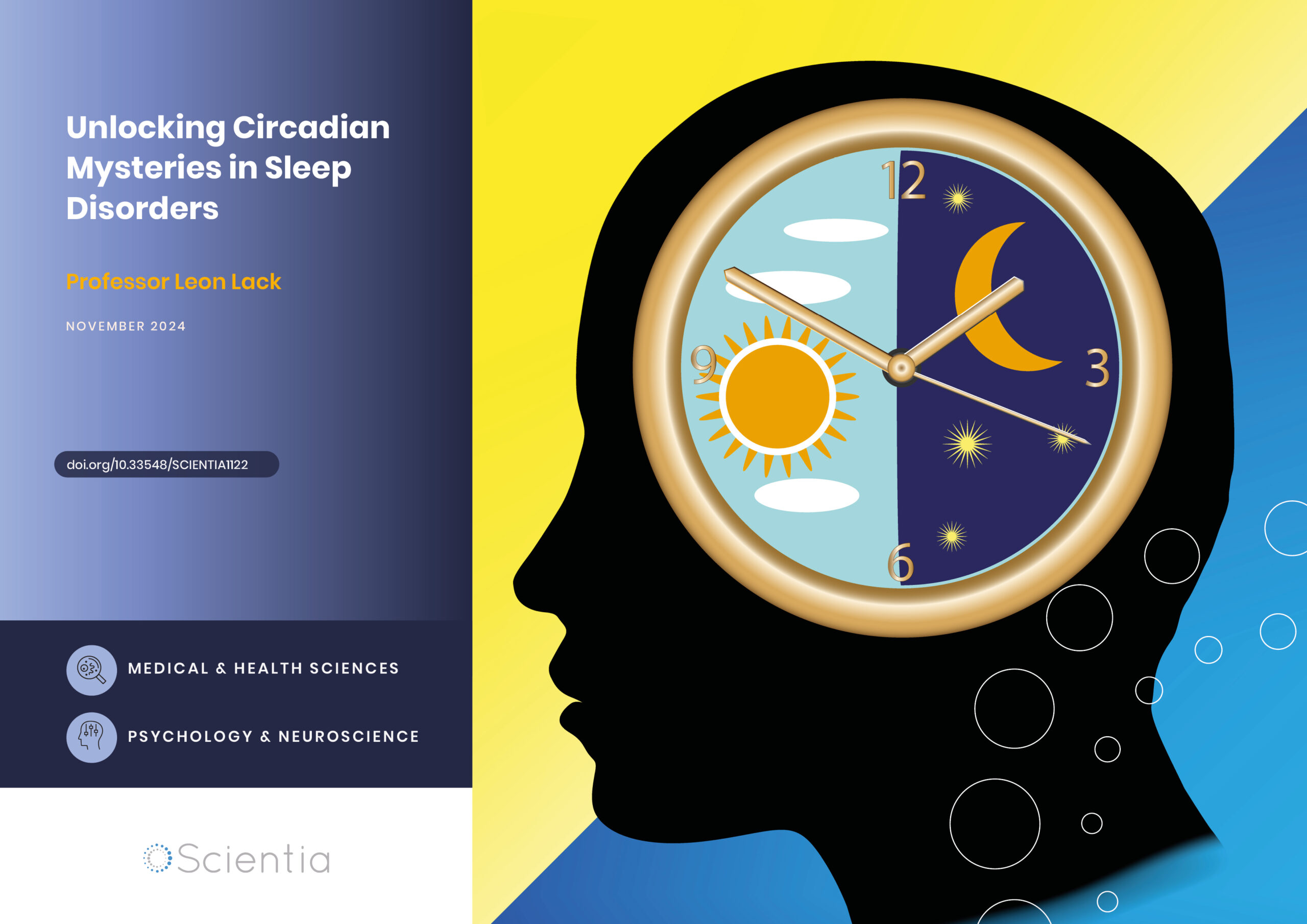Dr Michael Schutz – Musical Alarms: Improving Medical Environments by Studying Sound
Incessant ‘beeps’ from medical devices are an all-too-common feature of hospital environments. Whether monitoring patient vital signs or warning of imminent emergencies, they form an integral part of modern clinical practice. For historical reasons, these devices generally communicate using simplistic beeps. This creates significant problems for both clinicians (who can struggle to differentiate the messages) and patients (who find them annoying and frustrating). Dr Michael Schutz from McMaster University is applying insights from musicians’ use of sound to improve the quality of the auditory signals used in the life saving devices filling hospitals around the world.
Auditory Alarms in the Medical Setting
Our senses offer a path to understanding the world around us. We often use our eyes to connect with technology using visual interfaces – such as computer screens. However, in some situations, auditory interfaces can be more effective. For example, medical devices in hospitals use auditory interfaces to keep doctors and nurses updated while keeping their eyes focused on patients (which is crucial when engaged in complex procedures, such as placing a breathing tube).
Although these signals warn clinicians of serious medical emergencies, often they serve to communicate more mundane information. For example, the steady beep of a pulse oximeter provides updates on a patient’s blood oxygenation saturation every time their heart beats.
Although they are crucial, designers of these sophisticated machines have traditionally overlooked the importance of the sounds used in their auditory alarms. The lack of sophistication in these tones render them annoying and distracting, posing risks for patient care and harming communication amongst medical staff. This is unfortunate and unnecessary, as many low-priority alarms offer useful information that is not immediately critical yet are designed using sounds that immediately grab attention. Unfortunately, since different devices use similar ‘beeps’, lower priority alarms can easily mask higher priority alarms, preventing doctors from getting crucial information in a timely manner. Furthermore, the annoying beeps interrupt patients’ sleep, which is known to extend recovery times.
Dr Michael Schutz is working to apply knowledge from analysing music to propose new paths towards developing better sounds for these devices. He carries out his work at McMaster University in Ontario, Canada, where he founded a specialised laboratory to support his team’s research. In the Music, Acoustics, Perception & LEarning (MAPLE) lab, he mentors students making important discoveries on better approaches to structuring auditory alarms in medical devices.

A Meandering Musical Path Leads to Medical Insight
In one of his first papers published in 2007, Dr Schutz investigated how visual information changes how we ‘hear’ music. He showed videos of a world-renowned percussionist attempting to play long and short notes on the marimba, a large, xylophone-like instrument. He recorded the performer using physically long and short striking gestures, and ‘switched’ the sight and sound for half the trials. Participants rated their perception of the note’s length, unaware that some had been swapped.
Differences in the performer’s gesture failed to alter the resulting notes’ acoustic duration. Yet intriguingly, the gesture presented with the note changed the way participants heard the same acoustic information. This shows that watching the percussionist’s movement causes us to ‘hear’ the note differently. Apparently, the renowned musician’s long and short gestures failed to change the sound of his notes. Nonetheless, his gestures accidentally changed the way his notes sounded to audiences.
This finding of visual influence on the auditory evaluations of sound duration broke sharply with previous scientific inquiries. Dr Schutz subsequently documented that the reason for this discrepancy traces back to the complex nature of musical sounds – which contrast markedly with the simplistic tone beeps commonly used in auditory research.
The Structure of Sound
Sounds can be described in part through their ‘amplitude envelope’. This technical term refers to a sound’s ‘shape’ over time. Most natural sounds, including musical sounds, have complex shapes. For example, percussive sounds caused by impacts start quickly and begin decaying immediately. We typically find these dynamic sounds pleasing, and they are used frequently in music, for example, by instruments such as the piano, plucked harp and strummed guitar. In contrast, machine-produced beeps use markedly different shapes – including rapid offsets. This makes them very different from sounds heard in everyday listening as well as in music.
From an artistic perspective, a sound’s complexity plays a crucial role in the musical property of timbre. Timbre is what makes instruments sound different from one another, even when playing the same melody – a sort of ‘acoustic fingerprint’. The individual components of both complex music sounds (left) and standard machine beeps (right) are shown above. This type of 3D representation illustrates each component, or harmonic, on the horizontal (x) axis. Additionally, it shows the way each component’s energy (vertical, y axis) changes over time (z axis). In musical instruments such as the violin, the strength of individual components varies continually over time, with each component moving somewhat independently (left image). Yet in many medical devices the components are relatively constant, and typically start and stop at the same time (right).
‘Through my network of collaborators, my team is now well positioned to build on our auditory perception research to improve the sonic landscape of hospitals.’

Real-life Applications
Further work by Dr Schutz has shown that greater attention to the importance of sound complexity is not only important for scientists studying listening, but also offers practical applications such as enhancing our perception of product value.
In 2019, Dr Schutz published a paper demonstrating that people were willing to pay 9% more for products using temporally complex (i.e., percussive-like wine glasses clinking) vs. simplistic (i.e., standard beep) sounds. Participants in that study received descriptions and pictures of two mobile phones and then heard sounds indicating a missed call. One of the phones used a percussive tone and the other standard beeps. Overall, 85% of people preferred the phone with the percussive tone, deemed it to be better quality, and would pay more for it. This illustrates the literal value-added as a result of better sound design – a crucial yet often under-appreciated aspect of product development.
For the moment, however, Dr Schutz and his team are focussing on applying their research to medical devices. Specifically, they are exploring how the use of sounds derived from music can be more effective at communicating with medical teams, while also being less irksome to patients and staff alike.
Many alarms follow the global medical standard set by the International Electrotechnical Commission, where sequences are made with three or five notes, all of which are based on standard beeps. Their simplistic shape requires them to be very short to avoid overlap. What might happen if each individual tone used a complex shape instead? This more complex approach would allow for the blending of notes into a sequence more similar to how music is structured. Dr Schutz’s team took this approach in their next study, conducted in collaboration with anaesthesiologist and intensivist Dr Joseph Schlesinger of Vanderbilt University Medical Center.
Participants in that study heard an alarm along with its indicated issue (e.g., temperature problems). They then responded to the alarm’s function when hearing it again, receiving feedback on their response. After a break to distract, they heard the alarm and again reported its function. Participants in this study were divided into two groups in which half heard alarms built on percussive tones and half heard alarms built on standard beep tones. Analysis of the responses indicates the type of sound used doesn’t affect participant recognition or learning, but it does have one crucial impact – the new approach using percussive tones is resoundingly less annoying.
This study holds exciting promise for real-world application. Alarms based on percussive sounds are just as effective at communicating as standard beeps. However, as they are less annoying, they could provide a positive adjustment to the environments of those being treated, recovering and working in medical facilities. Given the ubiquity of these medical device alarms used in hospitals around the world, even small changes like reducing annoyance hold significant potential to improve public health, offering benefits for both patients and medical professionals.
‘Dr Schutz’s work on music-inspired alarm design shows the benefits of careful attention to acoustical details, building bridges between functionality and aesthetics.’ Dr Özcan Vieira, Director of Critical Alarms Lab at Delft University of Technology and Erasmus Medical Centre Rotterdam.

Credit: Colin Czerneda
Using Novel Software to Explore Complex Sounds
The MAPLE Lab team has built a new software tool called MAESTRO, which is now freely available at www.maplelab.net/maestro. Originally designed for Dr Schutz’s teaching, his team now uses this software to generate sounds for their experiments as well. This tool eases the process of creating complex sounds, which is as useful in improving music cognition pedagogy as it is in assisting with crucial new experiments exploring the role of sound complexity in perception.
Drawing on his training and experience as both a professional musician and experimental psychologist, Dr Schutz bridges the traditional gap between music perception and music performance. His ongoing participation in music making through activities such as directing the McMaster Percussion Ensemble and performing at percussion festivals and music camps gives him a useful artistic perspective on the power of sound to communicate.
This insight, combined with his scientific training in conducting auditory experiments, has led to numerous discoveries that challenge conventional thinking about auditory perception, some with important practical applications for medicine and engineering. As Dr Elif Özcan Vieira, Director of Critical Alarms Lab at Delft University of Technology and Erasmus Medical Centre Rotterdam notes, ‘Dr Schutz’s work on music-inspired alarm design shows the benefits of careful attention to acoustical details, building bridges between functionality and aesthetics.’
Dr Schutz concludes by explaining ‘Through my network of collaborators, my team is now well positions to build on our auditory perception research to improve the sonic landscape of hospitals’. This could both increase safety and decrease risk for patients and health professionals alike. His recent TEDx talk on this subject is now available at www.maplelab.net/ted and an interview with CHCH-TV is available at https://www.chch.com/hospital-sound-check/.
Video
Reference
https://doi.org/10.33548/SCIENTIA696
Meet the researcher

Dr Michael Schutz
Associate Professor of Music Cognition/Percussion
McMaster University
Hamilton, ON
Canada
Dr Michael Schutz received his Bachelor of Science in Computer Science, as well as his Bachelor of Musical Arts in Percussion Performance from Pennsylvania State University. He also holds a Masters degree in Music Technology and Percussion Performance from Northwestern University, and an MA as well as a PhD in Psychology from the University of Virginia where he worked with Dr Michael Kubovy. He is currently an Associate Professor of Music Cognition/Percussion at McMaster University in Ontario, Canada, and serves as a core member of the McMaster Institute for Music and the Mind. As founding director of the MAPLE lab, Dr Schutz supervises a diverse portfolio of research projects carried out with his interdisciplinary team, exploring the psychological basis of music and how this knowledge can be applied to a broad range of scientific and artistic issues. He also directs the McMaster Percussion Ensemble and serves on percussion faculty at the Honors Music Institute in State College, Pennsylvania.
CONTACT
W: https://maplelab.net/ and michaelschutz.net
Twitter: @MAPLE_Lab
KEY COLLABORATORS
Joseph J. Schlesinger, MD, FCCM (Anesthesiology Critical Care Medicine, Vanderbilt University Medical Center)
Jennifer Campos, Senior Scientist, KITE (Toronto Rehab – University Health Network)
Jeanine Stefanucci (University of Utah, Salt Lake City UT)
Laura Silverman (Division of Developmental and Behavioral Pediatrics, University of Rochester Medical Center)
FUNDING
Natural Science and Engineer Council of Canada (NSERC)
Social Science and Humanities Research Council of Canada (SSHRC)
Canadian Foundation for Innovation (CFI)
Ontario Early Researcher Award (ERA)
McMaster International Initiatives Micro Fund
FURTHER READING
S Sreetharan, J Schlesinger, M Schutz, Decaying amplitude envelopes reduce alarm annoyance: Exploring new approaches to improving auditory interfaces, Applied Ergonomics, 2021, 96, 103432.
L Foley, CJ Anderson, M Schutz, Re-Sounding Alarms: Designing Ergonomic Auditory Interfaces by Embracing Musical Insights, Healthcare, 2020, 8(4), 389.
M Schutz, J Gillard, On the generalization of tones: A detailed exploration of non-speech auditory perception stimuli, Scientific reports, 2020, 10(1), 9520.
M Schutz, Acoustic Structure and Musical Function: Musical Notes Informing Auditory Research, The Oxford Handbook of Music and Neuroscience, Oxford University Press, 2019, 145–164.
M Schutz, JK Stefanucci, Exploring the Effects of “Sound Shape” on Consumer Preference, Ergonomics in Design, 2019, 27(1), 16–19.
J Gillard, M Schutz, Composing alarms: considering the musical aspects of auditory alarm design, Neurocase, 2016, 22(6), 566–576.
GT Vallet, DI Shore, M Schutz, Exploring the role of the amplitude envelope in duration estimation, Perception, 2014, 43(7), 616–630.
M Schutz, F Manning, Effectively using affective gestures What percussionists need to know about movement and perception, Percussive Notes, 2013, 51(2), 26–31.
M Schutz, M Kubovy, Causality and Cross-Modal Integration, Journal of Experimental Psychology: Human Perception and Performance, 2009, 35(6), 1791–1810.
M Schutz, S Lipscomb, Hearing gestures, seeing music: Vision influences perceived tone duration, Perception, 2007, 36(6), 888–897.

Want to republish our articles?
We encourage all formats of sharing and republishing of our articles. Whether you want to host on your website, publication or blog, we welcome this. Find out more
Creative Commons Licence
(CC BY 4.0)
This work is licensed under a Creative Commons Attribution 4.0 International License. 
What does this mean?
Share: You can copy and redistribute the material in any medium or format
Adapt: You can change, and build upon the material for any purpose, even commercially.
Credit: You must give appropriate credit, provide a link to the license, and indicate if changes were made.
More articles you may like
Professor Aristides Marcano Olaizola | Innovation in the Production of Singlet Oxygen
A novel method for producing singlet oxygen via stimulated Raman scattering (SRS) offers an innovative alternative to traditional photosensitizer-based techniques, promising safer and more efficient applications in disinfection, cancer treatment, and beyond. Professor Aristides Marcano Olaizola at Delaware State University is driving innovation in this critical field.
Dr Marta Berrocal-Lobo | Unlocking the Potential of Essential Oils: Illuminating Epigenetic Effects on Plant Defense Mechanisms
Essential oils (EO) are potent in enhancing plant stress responses and mitigating seed-borne diseases, particularly in high-value crops such as tomatoes. While their direct impacts are recognised, the indirect influences on plant growth, metabolism, and immune responses against phytopathogens remain uncertain. Dr Marta Berrocal-Lobo, an esteemed Associate Professor and researcher at the Polytechnic University of Madrid, in collaboration with the Group of Biopesticides led by Dr Azucena Gonzalez-Coloma, is unravelling the transcriptomic and metabolic responses of tomato seeds treated with an antifungal EO against the pathogen Fusarium oxysporum sp. Their findings pave the way for harnessing EO in sustainable agriculture.
Dr Linda Hammerich | Revolutionising Immune Monitoring with Flow Cytometry
Understanding the individual immune response is key to diagnosing and treating a range of diseases. One way of characterising immune cells is through flow cytometry, where cells are tagged with fluorescent markers known as fluorochromes. Detectors use these markers to understand the different physical and chemical features of the individual cells and the overall immune cell population. Dr Linda Hammerich and a team from Charité-Universitätsmedizin in Germany have optimised this technique to investigate up to 31 different cells or markers from one blood test using currently available technology.
Dr Leon Lack | Unlocking Circadian Mysteries in Sleep Disorders
Sleep disorders can significantly disrupt daily life, but their underlying causes are not always clear. Dr Leon Lack from Flinders University has spent decades studying these disorders and how to treat them. By shedding light on the role of circadian rhythms in delayed sleep-wake phase disorder and non-24-hour sleep-wake rhythm disorder, he hopes to unravel why some people struggle to maintain conventional sleep patterns and could lead to more effective treatments for these challenging conditions.




